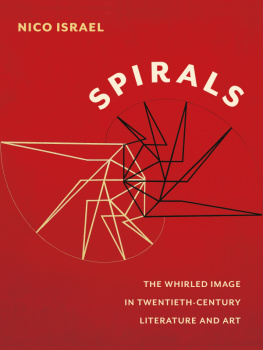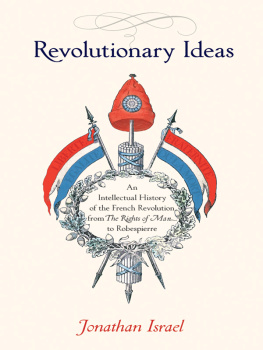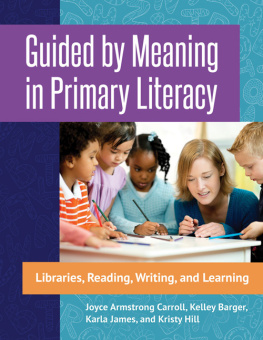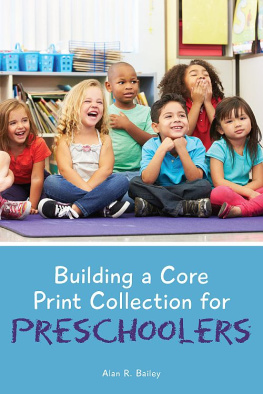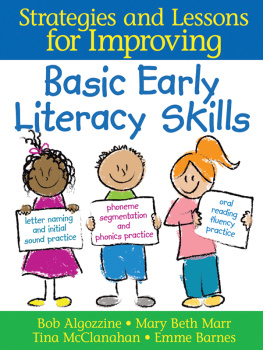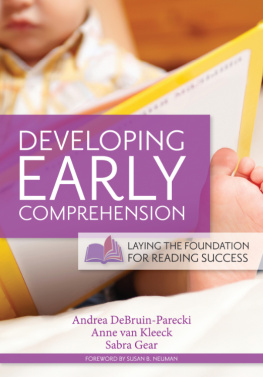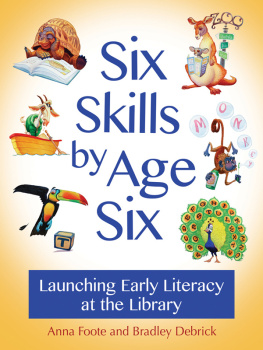Early
Reading First
and Beyond
In memory of my sister, Francis (May 23, 1969July 2, 2001). My sister, Fran, loved children very much. Growing up she was my best friend. She followed me to college after her study abroad experience in France. She loved playing soccer, listening to music, and playing her guitar. Fran would have loved to dedicate this book to the children at the School of Inquiry where she worked as a social worker for children most in need.
Susan E. Israel
Early
Reading First
and Beyond
A Guide to Building Early Literacy Skills

Copyright 2008 by Corwin Press
All rights reserved. When forms and sample documents are included, their use is authorized only by educators, local school sites, and/or noncommercial or nonprofit entities that have purchased the book. Except for that usage, no part of this book may be reproduced or utilized in any form or by any means, electronic or mechanical, including photocopying, recording, or by any information storage and retrieval system, without permission in writing from the publisher.
For information:
 | Corwin Press
A SAGE Company
2455 Teller Road
Thousand Oaks, California 91320
www.corwinpress.com | SAGE India Pvt. Ltd.
B 1/I 1 Mohan Cooperative Industrial Area
Mathura Road, New Delhi
India 110 044 |
SAGE Ltd.
1 Olivers Yard
55 City Road
London EC1Y 1SP
United Kingdom | SAGE Asia-Pacific Pte. Ltd.
33 Pekin Street #02-01
Far East Square
Singapore 048763 |
Printed in the United States of America.
Library of Congress Cataloging-in-Publication Data
Israel, Susan E.
Early reading first and beyond: a guide to building early literacy skills/Susan E. Israel.
p. cm.
Includes bibliographical references and index.
ISBN 978-1-4129-5101-2 (cloth)
ISBN 978-1-4129-5102-9 (pbk.)
1. Reading (Early childhood) 2. Literacy. 3. Reading comprehensionStudy and teaching (Early childhood)United States. 4. Metacognition in children. I. Title.
| LB1139.5.R43I84 2008 |
| 372.41dc22 | 2007023148 |
This book is printed on acid-free paper.
07 08 09 10 11 10 9 8 7 6 5 4 3 2 1
| Managing Editor: | Cathy Hernandez |
| Editorial Assistants: | Megan Bedell, Cathleen Mortensen |
| Production Editor: | Cassandra Margaret Seibel |
| Copy Editor: | Barbara Coster |
| Typesetter: | C&M Digitals (P) Ltd. |
| Proofreader: | Kevin Gleason |
| Indexer: | Holly Day |
| Cover Designer: | Scott Van Atta |
Contents
by Kathryn Bauserman
by Cynthia A. Lassonde
Preface
It is the supreme art of the teacher to awaken joy in creative expression and knowledge.
Albert Einstein
My early memories of childhood experiences are the ones when I was busy playing, doing art projects, going to the library, and building things with blocks and Legos. Einsteins quote is one of my favorites because I believe creative expression and knowledge begin at a very early age in a childs cognitive, social, and emotional development.
Susan E. Israel
E arly Reading First and Beyond is a book about prekindergarten literacy skill development, which research shows plays a key role in a childs later success in reading achievement. The U.S. Department of Educations response to this research is the Early Reading First initiativea program that emphasizes the importance of educating teachers who work with emerging readers. Based on the report of the National Reading Panel, Early Reading First is part of the No Child Left Behind act. The primary goal of Early Reading Firstthe development of literacy skills from birth to kindergartenis the focus of this book.
What motivated me to write this book was my love for small childrenall small children, not just a fewwho deserve to have opportunities during vital developmental moments in their lives for those rich literacy engagements that lead to success later in life. This book provides the tools and resources for early childhood educators to unlock childrens creativity to inspire them to develop readiness skills for kindergarten based on the Early Reading First initiative.
The goal of all teachers serving our young children should be to be highly qualified in their area of expertise. In addition, each teacher needs a willingness to engage in professional development for continued growth. It is my hope that by reading this book, early childhood educators will benefit from my research, experiences, and understanding of the time in a childs life from birth to kindergarten. This book will be useful as teachers reflect on their own professional development needs.
LEAVING NO EARLY CHILDHOOD EDUCATOR BEHIND
This book was written to meet the needs of educators at the emergent level who work to develop literacy for early primary grade children. The responsibility of scaffolding early primary grade children toward future literacy success does not rest in the hands of only a few people. Those who will benefit from reading this book include the following:
- Early childhood educators
- Administrators in early childhood
- Undergraduate or graduate-level professionals who teach early childhood courses in literacy and education
- School leaders who wish to engage in professional development
- Literacy coaches
- Early primary reading specialists
- School district curriculum developers
- Policymakers who work in early childhood
- Librarians who engage in literacy development activities
- Most important, parents of young children who desire to understand and implement Early Reading First goals
THINKING CREATIVELY ABOUT EARLY CHILDHOOD LITERACY DEVELOPMENT
This book offers the field of literacy a format that will appeal to those working with early childhoodage children or those who want to construct early childhood programs of excellence. It also provides teachers and parents with creative teaching that will guide their instruction related to the key components of Early Reading First. provides an overview of research and strategies you will find in this book.
Detailed current research-based strategies with literacy instruction that integrate the key components presented are as follows:
- Oral language
- Alphabetic knowledge
- Phonological awareness
- Print awareness
Each chapter includes unique features to aid in developing a deeper understanding of the chapter contents for the readers. The unique features provide a consistent reading path throughout the book, making reading comprehension more efficient for the reader. These unique features are as follows:
Vignettes: An opening vignette illustrates the chapter contents and highlights key aspects of experiences in early childhood. Vignettes are provided to stimulate the readers background knowledge on the topic.
Table 0.1 Matrix of Early Reading First Research, Strategies, and Benefits
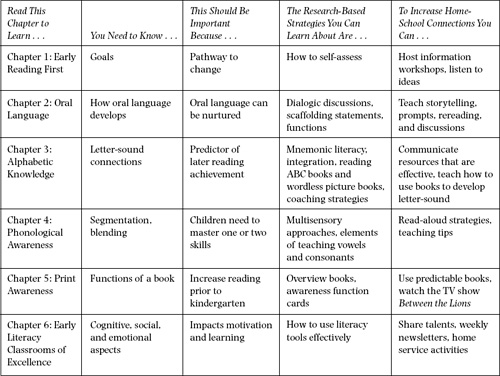
Research That Early Childhood Teachers Need to Know:
Next page

